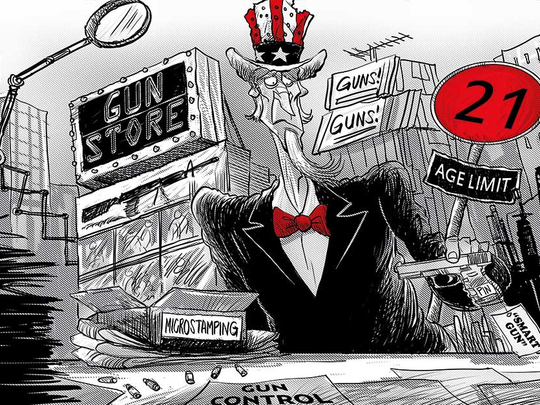
After the horrific mass shooting in Las Vegas, the impulse of politicians will be to lower flags, offer moments of silence and lead a national mourning in America. Yet, what America needs most of all isn’t mourning, but action to lower the toll of guns in America.
America doesn’t need to simply acquiesce to this kind of slaughter. When Australia suffered a mass shooting in 1996, the country united behind tougher laws on firearms. As a result, the gun homicide rate was almost halved, and the gun suicide rate dropped by half, according to the Journal of Public Health Policy.
Sceptics will say that there are no magic wands and that laws can’t make the carnage go away. To some extent, they’re right. Some criminals will always be able to obtain guns, especially in a country like America that is awash with 300 million firearms. America is always likely to have higher gun death rates than Europe.
But the scale is staggering. Since 1970, more Americans have died from guns (including suicides, murders and accidents) than the sum total of all the Americans who died in all the wars in American history, back to the American Revolution. Every day, some 92 Americans die from guns, and American children are 14 times as likely to die from guns as children in other developed countries, according to David Hemenway of Harvard.
So while there’s no magic wand available, here are some steps that could be taken that would, collectively, make a difference:
n 1. Impose universal background checks for anyone buying a gun. Four out of five Americans support this measure to prevent criminals or terrorists from obtaining guns.
n 2. Impose a minimum age-limit of 21 on gun purchases. This is already the law for handgun purchases in many states, and it mirrors the law on buying alcohol.
n 3. Enforce a ban on possession of guns by anyone subject to a domestic violence protection order. This is a moment when people are upset and prone to violence against their exes.
n 4. Limit gun purchases by any one person to no more than, say, two a month, and tighten rules on straw purchasers who buy for criminals. Make serial numbers harder to remove.
n 5. Adopt microstamping of cartridges so that they can be traced to the gun that fired them, useful for solving gun crimes.
n 6. Invest in “smart gun” purchases by police departments or the United States military, to promote their use. Such guns require a PIN or can only be fired when near a particular bracelet or other device, so that children cannot misuse them and they are less vulnerable to theft. The gun industry made a childproof gun in the 1800s, but now resists smart guns.
n 7. Require safe storage, to reduce theft, suicide and accidents by children.
n 8. Invest in research to see what interventions will be more effective in reducing gun deaths. We know, for example, that alcohol and guns don’t mix, but we don’t know precisely what laws would be most effective in reducing the resulting toll. Similar investments in reducing other kinds of accidental deaths have been very effective.
These are all modest steps, and I can’t claim that they would have an overwhelming effect. But public health experts think it’s plausible that a series of well-crafted safety measures like these could reduce gun deaths by one-third — or more than 10,000 a year.
Suicides outnumber murders
It’s too soon to know what, if anything, might have prevented the shooting in Las Vegas, and it may be that nothing could have prevented it. In some ways, these mass shootings are anomalies: Most gun deaths occur in ones or twos, usually with handguns (which kill far more people than assault rifles), and suicides outnumber murders.
But in every other sphere, we at least use safety regulations to try — however imperfectly — to reduce death and injury. For example, the Occupational Safety and Health Administration has seven pages of rules about ladders, which kill 300 people a year. Yet the federal government doesn’t make a serious effort to reduce gun deaths, with a toll more than 100 times as high.
The best example of intelligent regulation is auto safety. By my calculations, America has reduced the auto-fatality rate per 100 million miles driven by more than 95 per cent since 1921. There was no single solution, but rather many incremental efforts: Seat belts, air bags, padded dashboards, better bumpers, lighted roads, highway guardrails, graduated licences for young people, crackdowns on drunken driving, limits on left turns, and so on. America hasn’t banned automobiles, and it hasn’t eliminated auto-related deaths, but it has learnt to make them safer — and the same should be done with guns.
The gun lobby will say that this isn’t a time for politics. But if we can’t learn the lesson from this carnage, then there will be more such shootings — again and again. This is a particularly American tragedy and completely unnecessary.
So let’s mourn. But even more important — let’s act.
— New York Times News Service
Nicholas Kristof is an American journalist, author and a winner of two Pulitzer Prizes.











